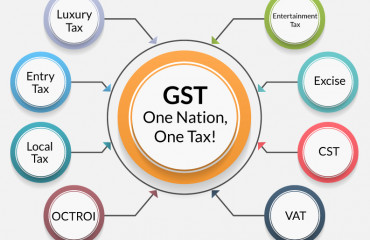
Last month, we celebrated seven years of the rollout of the goods and services tax (GST). Its promise has been the elimination of the cascading impact of a tax on tax, inbuilt interlocking incentives which improve compliance, less tax leakage and the removal of friction in commerce across state boundaries.
Last month, we celebrated seven years of the rollout of the goods and services tax (GST). Its promise has been the elimination of the cascading impact of a tax on tax, inbuilt interlocking incentives which improve compliance, less tax leakage and the removal of friction in commerce across state boundaries.
For small businesses, especially, it opens up a customer base across the country using e-commerce. Presently, there are 14.6 million active taxpayers, of which nearly 10.4 million have come in the post-GST regime and are therefore new registrations. They represent a formalization of the economy. To what extent have small businesses benefited from this formalization?
Examining the Annual Survey of Unincorporated Sector Enterprises (ASUSE) can help answer this. The survey is conducted by the ministry of statistics and programme implementation. Key findings are now available for the 2021-22 and 2022-23 editions.
The one prior to this was thwarted due to covid,. And before 2015-16, this survey was conducted only once every five years. The recent surveys offer insight into the working and prospects of micro, small and medium enterprises (MSME).
Also read: Fintechs and NBFCs can solve credit issues for SMEs and MSMEs, says Vikas Singh of Sugmya Finance
It covers only unincorporated businesses. Several committees have studied the challenges MSMEs face and the policies needed for their healthy growth. An MSME law was passed in 2006. There is a ministry devoted to MSMEs in the Union government as well as in most states.
Yet, MSME's, especially small ones, face numerous challenges of formalization. Their economic health is crucial for India to achieve employment-intensive and inclusive growth. That growth is supposed to be aided by the formalization of the economy, catalysed by the GST rollout.
Over the two surveys, from 2021 till 2023, the number of enterprises rose from 59.7 to 65.4 million, and the corresponding employment from 97.9 million to 109.6 million. The employment numbers include single person-owned enterprises and are lower than in the 2016 survey.
These are non-farm enterprises excluding factories, companies and non-profits. The lack of robust growth in employment corroborates other evidence of a rise in farm employment post-covid.
Of the 65.4 million enterprises, 82.6% have an annual turnover of less than ₹5 lakh. Almost 99% of the unincorporated enterprises have turnover of less than ₹50 lakhs, and merely 0.3% have more than ₹1 crore. More tellingly, only 2% are registered for GST.
Two-thirds of all unincorporated enterprises are not registered under any act or authority. Note, a lot of the benefits to small businesses are linked to their registration on UDYAM. These include collateral free loans under schemes like the Credit Guarantee Fund Trust for Micro and Small Enterprises.
The latest budget included an additional ₹9,000 crore towards this trust, and to increase funding to small businesses. Other benefits tied to registration are access to priority sector loans, lower interest rates, exemption from earnest money deposit requirement, preferential treatment in government procurement, among others.
Also read: Can Budget 2024 pave the way for easier MSME loans?
Yet, till early 2023, two-thirds of all unincorporated enterprises were outside the formal tax and registration net. Why do they choose to forgo the benefits of formalization?
Some of this might have changed in 2023-24 when, as per the UDYAM portal, there were 24.9 million new registrations, and a further 6.34 million this fiscal year. So, the momentum is picking up.
As per the survey, there is a big difference in the turnover and the gross value addition (GVA) by those who file GST and those who don't. The former have an average turnover of ₹4.1 million and GVA of ₹1.6 million while the latter have turnover of ₹0.4 million and GVA of only ₹0.2 million.
This shows that for micro businesses, complying with GST is difficult. One curious finding is on the value added by all the 65.4 million enterprises. The total value for GVA is reported at ₹15.4 trillion, which translates to barely 5% of gross domestic product (GDP).
But the conventional understanding is that MSMEs contribute nearly 40% to value addition or at least the GDP. This wide divergence cannot simply be explained by dividing MSMEs into incorporated and unincorporated and asserting that it is the former that provide the bulk of the value addition. Deeper study is needed.
A large section of informal small businesses involves sales of products and services directly to the end customer at wafer thin margins. These could be, for instance, selling vegetables or carrying out shoe repair, and often are single-person enterprises.
For them, entering the GST net has a disincentive, even if they grow above the exemption threshold, since they do not derive any input tax credit, nor can they pass on the burden to their customer due to a competitive market. How then can we motivate them to join GST?
There is also a significant cost related to financial literacy barrier and compliance. This can be addressed through more GST helpdesks (sewa kendras) and a free, easy to use super-app that caters to all their tax, procurement, billing, inventory and planning needs. Just as BHIM was developed for digital payments, so is an enterprise resource planning needed for micro businesses.
Undoubtedly, formalization helps small businesses scale up and improve viability. It also helps them access the bill discounting market to address problem of delayed payments.
Also read: An action plan to ensure small businesses don't fall short of credit
But their entry into the formal economy, even to join the GST network or access formal credit, poses hurdles, which call for innovative and enabling policies
